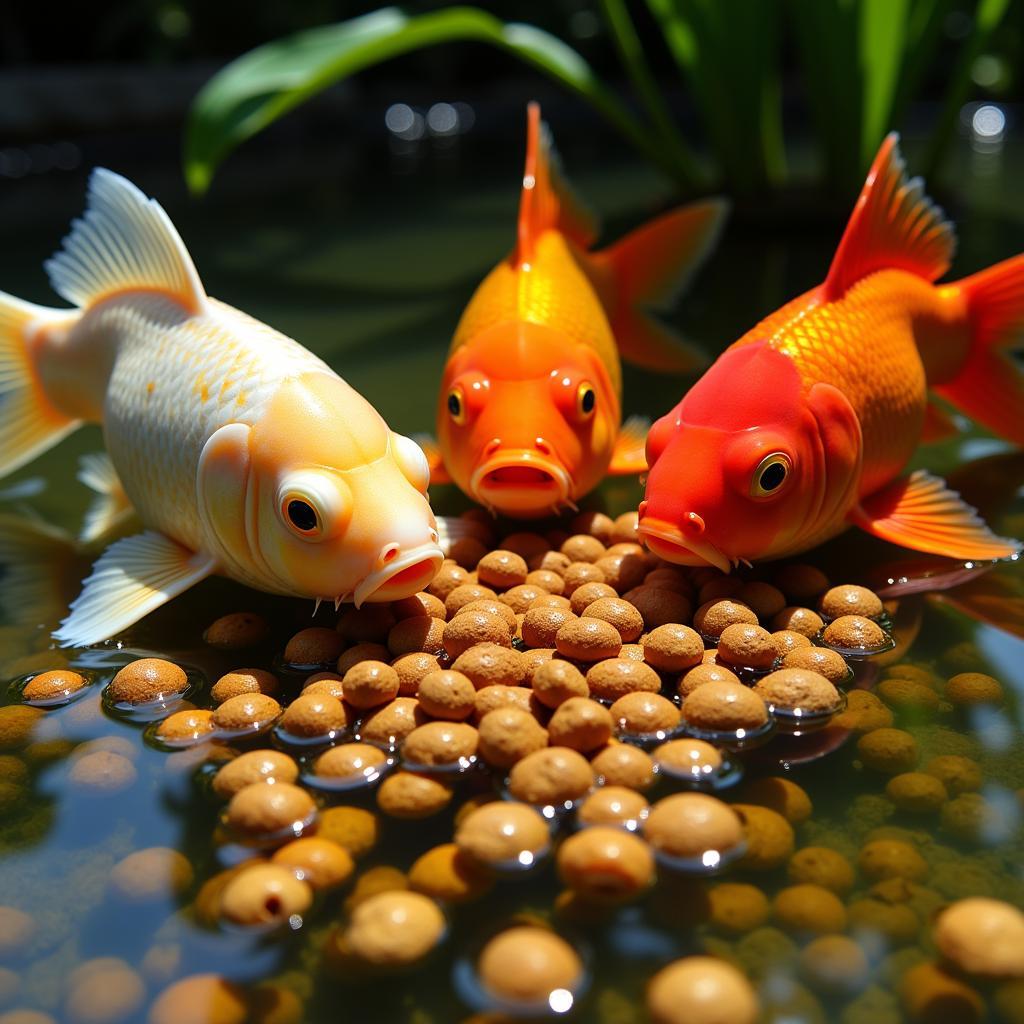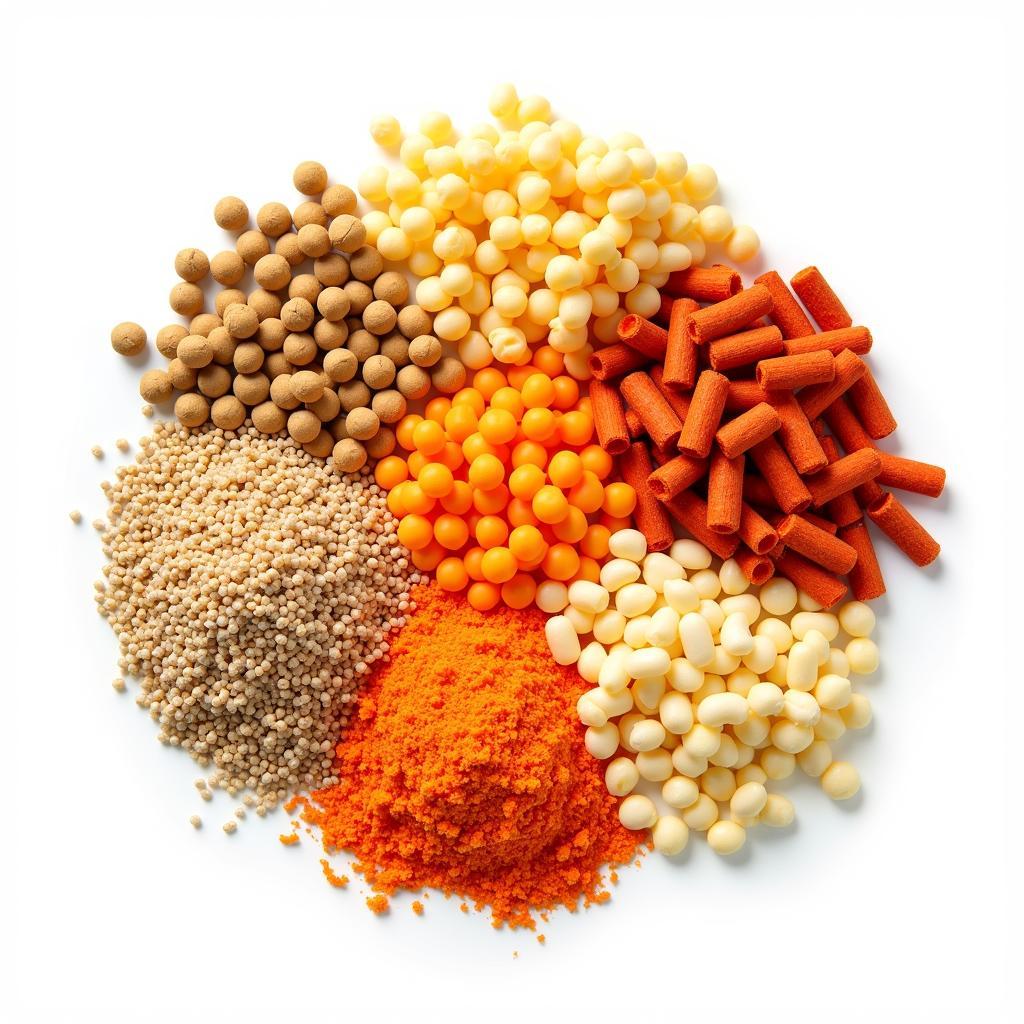Goldfish Food For Ponds is a crucial aspect of keeping your finned friends happy and healthy. Choosing the right food can significantly impact their growth, color vibrancy, and overall well-being. This comprehensive guide will dive deep into everything you need to know about selecting the perfect goldfish food for your pond.  Goldfish eagerly consuming food in a pond
Goldfish eagerly consuming food in a pond
Understanding Your Goldfish’s Dietary Needs
Just like us, goldfish require a balanced diet to thrive. Their nutritional needs vary depending on the season, water temperature, and their age. A varied diet consisting of high-quality goldfish and koi food will ensure they receive all the essential vitamins and minerals for optimal health. For example, during warmer months, they need more protein-rich food to support their increased activity levels. In contrast, during colder months, their metabolism slows down, and they require less food.
Importance of Protein, Carbohydrates, and Fats
Protein is essential for building and repairing tissues, promoting growth, and supporting a healthy immune system. Carbohydrates provide energy for daily activities, while fats are crucial for maintaining cell function and storing energy. A well-balanced good koi food will typically contain a blend of these essential nutrients.
Types of Goldfish Food for Ponds
There is a wide variety of goldfish food available, each with its own advantages and disadvantages. Understanding the different types can help you make an informed decision for your pond’s inhabitants.
Floating vs. Sinking Goldfish Food
- Floating food: Floating pond fish food allows you to easily monitor how much your goldfish are eating and prevents uneaten food from sinking to the bottom and decaying, which can negatively impact water quality.
- Sinking food: Goldfish sinking food caters to bottom-feeding goldfish and helps prevent surface-feeding fish from consuming all the food. However, it can be challenging to monitor how much food is being consumed.
Pellets, Flakes, and Sticks
- Fish food pellets: Pellets are a popular choice as they come in various sizes and formulations, catering to different goldfish sizes and dietary needs.
- Flakes: Flakes are a good option for smaller goldfish or fry, but they can quickly cloud the water if not eaten promptly.
- Sticks: Sticks offer a more substantial meal and can be a good option for larger goldfish.
 Different types of goldfish food: pellets, flakes, and sticks.
Different types of goldfish food: pellets, flakes, and sticks.
Choosing the Right Goldfish Food
Selecting the right goldfish food for ponds involves considering several factors, including the age and size of your goldfish, the season, and the specific dietary requirements of your fish. Remember, a high-quality diet is a cornerstone of healthy and vibrant goldfish.
What is the best goldfish food for ponds?
The “best” food truly depends on the individual needs of your goldfish. Look for high-quality ingredients, avoiding fillers and artificial colors. Opt for a food that offers a balanced blend of protein, carbohydrates, and fats.
How much should I feed my pond goldfish?
A good rule of thumb is to feed your goldfish only what they can consume in a few minutes, typically two to three times a day. Overfeeding can lead to poor water quality and health problems.
Conclusion
Choosing the right goldfish food for ponds is a vital part of responsible pond ownership. By understanding your goldfish’s dietary needs and selecting high-quality food, you can ensure they thrive and bring years of enjoyment to your pond. Remember to feed them appropriately and monitor their health regularly. Goldfish food for ponds can be easily managed with the right knowledge and a little bit of care.
FAQ
- What do goldfish eat in a pond besides food? Goldfish will also consume algae and other small organisms present in the pond.
- Can I feed my goldfish human food? While some human foods are safe in moderation, it’s best to stick to commercially prepared goldfish food designed to meet their nutritional needs.
- How often should I clean my pond? Regular partial water changes and debris removal are essential for maintaining a healthy pond environment.
- What are signs of an unhealthy goldfish? Lethargy, loss of appetite, discoloration, and unusual swimming patterns can indicate health problems.
- Do goldfish need a heater in a pond? Goldfish are generally cold-water fish and can tolerate a wide range of temperatures. Heaters are typically only necessary in extremely cold climates.
- How can I prevent algae growth in my pond? Proper filtration, avoiding overfeeding, and introducing aquatic plants can help control algae growth.
- Can goldfish live with other fish in a pond? Certain fish species are compatible with goldfish, while others may not be. Research compatibility before introducing new fish to your pond.
If you need assistance, please contact us via phone at 02437655121, email at minacones@gmail.com, or visit us at 3PGH+8R9, ĐT70A, thôn Trung, Bắc Từ Liêm, Hà Nội, Việt Nam. We have a 24/7 customer service team.